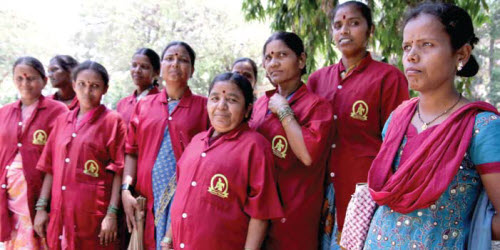Creating Biogas from Organic Waste
A key innovation in PV’s model is the adoption of a locally viable technology for biogas creation, called the Nisargruna Biogas Plant. The technology was developed to convert on-site organic waste at an individual institution or apartment building into useful methane and high-quality manure (fertilizer) to then be sold back to households or local businesses. It was designed to digest almost any biodegradable waste including kitchen waste, paper, animal dung, bio-sludge, poultry manure, agro-waste, and biomass.
The Nisargruna Biogas technology has three stages of operation. First, waste must be properly separated before entering the biogas plant as some materials may damage the equipment. Even with good source separation, waste pickers conduct a sort on-site to pick out contaminants and inappropriate organic material. Hence waste pickers are a critical part of the operation’s smooth functioning. Second, because microorganisms cannot easily digest solid waste, the waste is placed in a mixer with an equal amount of hot water to break down fibers and create a homogeneous slurry. This slurry enters into the aerobic tank to be converted to butyric, fumaric, acetic, and other organic acids. Finally, the acidic slurry transfers to the anaerobic tank, to be converted into methane. The final products are nitrogen-rich manure, to be used on gardens, and methane gas, which can be used for heating or electricity. The water used in the process is heated through solar power and recycled for new batches. Out of every 100 liters of water used, 75 liters are recycled from the slurry.
Plant operation is relatively simple as the technology was designed to be used by non-skilled workers. And, unlike composting operations, a biogas plant does not create unpleasant decomposing odors, nor does it take up a large amount of space. Only 50 m2 are required for a plant that processes 100 kg per day. The resulting biogas is 85 percent methane, more efficient than the 50 percent methane typical of most biogas plants, which SMS attributes to Nisargruna’s two-step aerobic/anaerobic process. The small footprint, lack of odors, and direct use of biogas for heating mean that organic waste, the largest part of the waste stream, can be processed and used very close to where it is produced. This dramatically reduces the need for waste pick up, transport, and disposal, as well as the pollution associated with these activities. It also avoids the pollution that results from landfilling wet waste: methane emissions, toxic leachate, and odors.
The municipality saves considerable money in avoided transport and disposal costs. The city pays private contractors about US $11 per ton to transport the waste and another US $9 for disposal. So each one ton/day plant saves the city in excess of US $6,000 per year. These costs are not reimbursed to PV.
For a biogas plant handling five metric tons per day of wet waste, the environmental benefits are significant. On an annual basis, the plant saves greenhouse gas emissions equivalent to 4,197 tons of CO2 from recycling wet waste. The same plant creates, annually, biogas equivalent to 55,000 kg of liquefied petroleum gas and 10,000 kg of organic compost. This is in addition to the reduced impact of transportation on Mumbai’s crowded streets.
SMS has successfully demonstrated the viability of decentralized waste management in one of the world’s largest and most crowded cities. Although this approach takes more time to roll out than a one size-fits-all city-wide strategy, its greater flexibility and customization is important to its success. Waste picker cooperatives are instrumental in managing source separation, and the small-scale biogas and compost pits have generated higher-paying employment for women waste pickers while significantly reducing the waste burden on the municipality.
Check out GAIA’s website here and download the full Zero Waste report here. Follow GAIA on Facebook and Twitter.
Read more from Other Worlds here, and follow us on Facebook and Twitter!
Copyleft GAIA. You may reprint this article in whole or in part. Please credit any text or original research you use to Global Alliance for Incinerator Alternatives, On the Road to Zero Waste: Successes and Lessons from Around the World.


Rinkesh
I live near Mumbai but never heard of anything like that. No doubt, a great initiative towards clean and green environment. Thanks for posting this.
Henry
That’s very encouraging. I like the idea of treating organic waste with biogas digesters because that is one of the routes to a pollution-free world. The concept is really a good business idea – partnering with businesses to supply you with sorted waste.